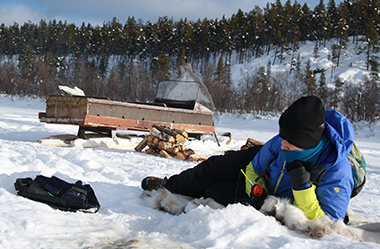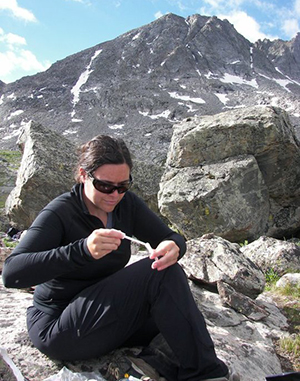5 Questions with Faculty: Cara Ocobock
 |
|
Cara Ocobock takes a break from data collection to do some ice fishing at a river near the Sami village Kuttura. (Photo by Minna Turunen)
|
ALBANY, N.Y. (October 5, 2016) — Cara Ocobock, an assistant professor in the Department of Anthropology, studies biological anthropology, focusing the physiological and behavioral adaptations needed to cope with extreme conditions, such as in northern North American and Finland.
She’s in her first semester at UAlbany, and considers herself “lucky to be surrounded by colleagues and students who delight in intellectual conversation.”
What are you working on now?
I am developing a field site to work among the reindeer herders in the Sápmi region of Finland. This project will focus on the metabolic cost of the annual herd round-up. I will collect data, including the number of calories the Sámi expend daily, activity levels, dietary intake, body composition and biomarkers such as glucose and cholesterol levels.
This is just the beginning. I also have my sights set on brown adipose tissue data collection, and the role that culturally specific skills play in herding and arctic living success.
 |
|
Ocobock pipets urine to measure energy expenditure, working in the field in the Wind River Range of the Wyoming Rockies. (photo by Ryan Hutchins-Cabibi)
|
Why did you become an anthropologist?
I had a fascination with how the human body worked. Figuring I would pursue a career in medicine, I followed the typical pre-med undergraduate trajectory. Then I took an anthropology class to fulfill a requirement, and fell in love! Human evolution, in particular, was a whole new world with a whole new set of unanswered questions.
I loved the idea that our evolutionary history is encoded in us and still affects us today. I slowly realized I would rather have a career in biological anthropology than medicine. In academia, I have the freedom to pursue different research questions and change those research pursuits along the way. And my research means I get to collaborate with people all over the world, share ideas, learn from them and travel.
I also have the opportunity to interact with students with the hope that I will light a fire in them like the one that was lit in me.
What are some of the challenges in your field?
I see two pressing challenges in the field I’ll define broadly as scientific inquiry: The way women are viewed and treated, and the misrepresentation of science in the media.
There’s been a lot of news recently on sexual harassment and “mansplaining” in academia, and the sciences in particular. Women in academia also face wage gaps, poor retention at the higher levels, biased peer review, outdated views of family obligations and work-life balance, and painfully persistent stereotypes about “female appropriate” fields of academic inquiry.
It is going to take a massive collaborative, multi-level approach to truly address these issues. I think every one of us can start by calling out gender-bias when we see it, making inappropriate behavior truly unacceptable.
Anti-science rhetoric and misrepresentation of research in the media hinder scientific understanding and progress. The inaccessibility of scientists and scientific writing adds fuel to the fire. In today’s world, we can ill-afford to ignore the potential solutions science can provide.
Finding ways to bring science to the community is key to bridging the gap between the public and the scientists. Such interactions will help make the public conscientious consumers of information, better arming them against dubious media segments on health and science.
I think one of the best ways to address these two challenges is to highlight the wonderful women doing amazing work. Invite them to talks. Invite them to be panelists. Invite them to media spots on television and radio.
What is the last book you read for pleasure?
When Breath Becomes Air. This book was written, though not completed, by young neurosurgeon who was diagnosed with and eventually died of stage IV lung cancer. Uplifting, right? I will always have a deep love of all things medical, which is obvious to anyone who looks at my Netflix queue or “fun-reading” bookshelf.
The book is beautifully written and provides an illuminating perspective. The doctor became the patient, changing how he viewed and practiced medicine. It serves as a reminder, in my roles as a researcher and teacher, to avoid tunnel vision and take a look from the other side.
What’s one thing students might be surprised to know about you?
I love weightlifting and lifting heavy. I dabbled in powerlifting for a couple of years, and I am slowly getting back into it. When I first started it was an outlet of frustration and anger; as I continued, however, I started taking joy in the lifting itself. After a good day of weightlifting, I definitely walk around with a swagger… though it could just as easily be a limp!
![]() For more news, subscribe to UAlbany's RSS headline feeds
For more news, subscribe to UAlbany's RSS headline feeds
A comprehensive public research university, the University at Albany-SUNY offers more than 120 undergraduate majors and minors and 125 master's, doctoral and graduate certificate programs. UAlbany is a leader among all New York State colleges and universities in such diverse fields as atmospheric and environmental sciences, business, education, public health,health sciences, criminal justice, emergency preparedness, engineering and applied sciences, informatics, public administration, social welfare and sociology, taught by an extensive roster of faculty experts. It also offers expanded academic and research opportunities for students through an affiliation with Albany Law School. With a curriculum enhanced by 600 study-abroad opportunities, UAlbany launches great careers.


